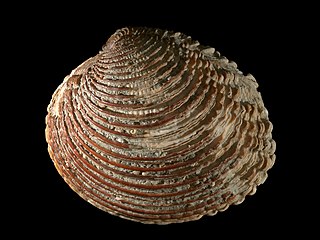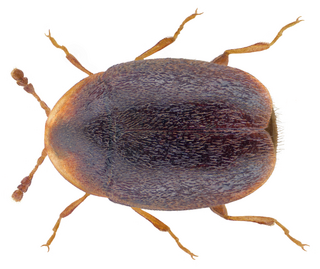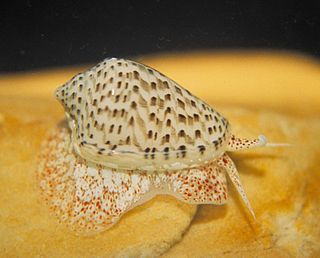
John Edward Gray was a British zoologist. He was the elder brother of zoologist George Robert Gray and son of the pharmacologist and botanist Samuel Frederick Gray (1766–1828). The standard author abbreviation J.E.Gray is used to indicate this person as the author when citing a botanical name. The same is used for a zoological name.

The Veneridae or venerids, common name: Venus clams, are a very large family of minute to large, saltwater clams, marine bivalve molluscs. Over 500 living species of venerid bivalves are known, most of which are edible, and many of which are exploited as food sources.

Corylophidae is a family of minute hooded beetles, sometimes called minute fungus beetles, in the superfamily Coccinelloidea. There are about 18 genera and at least 120 described species in Corylophidae. They feed on microfungi such as molds, and are often found associated with bark, as well as in leaf litter and other decaying vegetation. In older literature, the family name was often given as Orthoperidae.

Marginellidae, or the margin shells, are a taxonomic family of small, often colorful, sea snails, marine gastropod molluscs in the clade Neogastropoda.
Parictis is an extinct arctoid belonging to the family Subparictidae.

Herpestes is a genus within the mongoose family Herpestidae. Several species in the family are known as slender mongooses. It is the type genus of the family, and comprises 5-6 living species, each with several subspecies. Fossil remains of three prehistoric species were excavated in France, and described in 1853.

Carditidae is a family of marine bivalve clams of the order Carditida, which was long included in the Venerida. They are the type taxon of the superfamily Carditoidea.

The Viverrinae represent the largest subfamily of the Viverridae comprising three genera, which are subdivided into six species native to Africa and Southeast Asia. This subfamily was denominated and first described by John Edward Gray in 1864.
Tropidodiscidae is an extinct family of Paleozoic fossil molluscs with isostrophically coiled shells. They are of uncertain position taxonomically, in other words it is not known whether they were s.

Fordilla is an extinct genus of early bivalves, one of two genera in the extinct family Fordillidae. The genus is known solely from Early Cambrian fossils found in North America, Greenland, Europe, the Middle East, and Asia. The genus currently contains three described species, Fordilla germanica, Fordilla sibirica, and the type species Fordilla troyensis.
†Spironema is a genus of extinct (Cretaceous) sea snails, marine gastropod mollusks in the family Naticidae, the moon snails.
Pseudoperna is a genus of extinct very small oysters. Pseudoperna lived in tight groups. This small oyster is commonly found attached in groups to the shell of large species such as Inoceramus. Pycnodonte and Pseudoperna are preserved mostly as calcitic valves and are also found attached to Mytiloides.

Tellinoidea is a taxonomic superfamily of saltwater clams, marine bivalve molluscs in the order Cardiida.

The Bridger Formation is a geologic formation in southwestern Wyoming. It preserves fossils dating back to the Bridgerian and Uintan stages of the Paleogene Period. The formation was named by American geologist Ferdinand Vandeveer Hayden for Fort Bridger, which had itself been named for mountain man Jim Bridger. The Bridger Wilderness covers much of the Bridger Formation's area.

Meiocardia is a genus of marine bivalves in the family Glossidae.
This list of fossil molluscs described in 2021 is a list of new taxa of fossil molluscs that were described during the year 2021, as well as other significant discoveries and events related to molluscan paleontology that occurred in 2021.
Liostrea is a genus of extinct oysters, marine bivalve mollusks in the family Gryphaeidae.

Rastellum is an genus of extinct molluscs, which lived from the Middle Jurassic to the Late Cretaceous.












